2021 Lexus LC500C child restraint
[x] Cancel search: child restraintPage 45 of 410

431-1. For safe use
1
For safety and security■Adult*1
■Child*4
■Child restraint system with infant*5
WARNING
●Do not modify or replace the uphol-
stery of the front seat.
Condition and operation in the front passenger occupant classification
system
Indicator/warning light
“AIR BAG ON” and “AIR BAG OFF” indicator lights“AIR BAG ON”
SRS warning lightOff
Driver’s and front passenger’s seat belt reminder lightOff*2 or flashing*3
DevicesFront passenger airbagActivatedFront passenger knee airbag
Indicator/warning light
“AIR BAG ON” and “AIR BAG OFF” indicator lights“AIR BAG OFF” or
“AIR BAG ON”
*4
SRS warning lightOff
Driver’s and front passenger’s seat belt reminder lightOff*2 or flashing*3
DevicesFront passenger airbagDeactivated or acti-
vated
*4Front passenger knee airbag
Indicator/warning light
“AIR BAG ON” and “AIR BAG OFF” indicator lights“AIR BAG OFF”*6
SRS warning lightOff
Driver’s and front passenger’s seat belt reminder lightOff*2 or flashing*3
DevicesFront passenger airbagDeactivatedFront passenger knee airbag
Page 46 of 410

441-1. For safe use
■Unoccupied
■There is a malfunction in the system
*1: The system judges a person of adult size as an adult. When a smaller adult sits in the
front passenger seat, the system may not re cognize him/her as an adult depending on
his/her physique and posture.
*2: In the event the front passenger is wearing a seat belt.
*3: In the event the front passenger does not wear a seat belt
*4: For some children, child in se at, child in booster seat or child in convertible seat, the sys-
tem may not recognize him/her as a child. Factors which may affect this can be the phy-
sique or posture.
*5: Never install a rear-facing ch ild restraint system on the front passenger seat. A forward-
facing child restraint system sh ould only be installed on the front passenger seat when it
is unavoidable. ( P.48)
*6: In case the indicator light is not illuminated, consult this manual on how to install the child
restraint system properly. ( P.46)
Indicator/warning
light
“AIR BAG ON” and “AIR BAG OFF” indicator lights“AIR BAG OFF”
SRS warning light
OffDriver’s and front passenger’s seat belt reminder light
DevicesFront passenger airbagDeactivatedFront passenger knee airbag
Indicator/warning light
“AIR BAG ON” and “AIR BAG OFF” indicator lights“AIR BAG OFF”
SRS warning light
OnDriver’s and front passenger’s seat belt reminder light
DevicesFront passenger airbagDeactivatedFront passenger knee airbag
Page 48 of 410

461-2. Child safety
1-2.Child safety
Points to remember: P.46
Child restraint system: P.47
When using a child restraint system:
P.48
Child restraint system installation
method
• Fixed with a seat belt: P.50
• Fixed with a child restraint LATCH anchor: P.53
The laws of all 50 states of the U.S.A.
as well as Canada now require the use
of child restraint systems.
Prioritize and observe the warnings,
as well as the laws and regulations
for child restraint systems.
Use a child restraint system until the
Riding with children
Observe the following precautions
when children are in the vehicle.
Use a child restraint system appro-
priate for the child , until the child
becomes large enough to properly
wear the vehicle’s seat belt.
It is recommended that children
sit in the rear seats to avoid acci-
dental contact with the shift lever,
wiper switch, etc.
Use the window lock switch to
avoid children operating the
power window accidentally.
Do not let small children operate
equipment which may catch or
pinch body parts, such as the
power window, hood, trunk, seats
etc.
WARNING
■When children are in the vehicle
Never leave children unattended in the
vehicle, and never allow children to have
or use the key.
Children may be able to start the vehicle
or shift the vehicle into neutral. There is
also a danger that children may injure
themselves by playing with the windows
or other features of the vehicle. In addi-
tion, heat build-up or extremely cold
temperatures inside the vehicle can be
fatal to children.
Child restraint systems
Before installing a child restraint
system in the vehicle, there are pre-
cautions that need to be observed,
different types of child restraint sys-
tems, as well as installation meth-
ods, etc., written in this manual.
Use a child restraint system when
riding with a small child that cannot
properly use a seat belt. For the
child’s safety, install the child
restraint system to a rear seat. Be
sure to follow the installation method
that is in the operation manual
enclosed with the restraint system.
Table of contents
Points to remember
Page 49 of 410
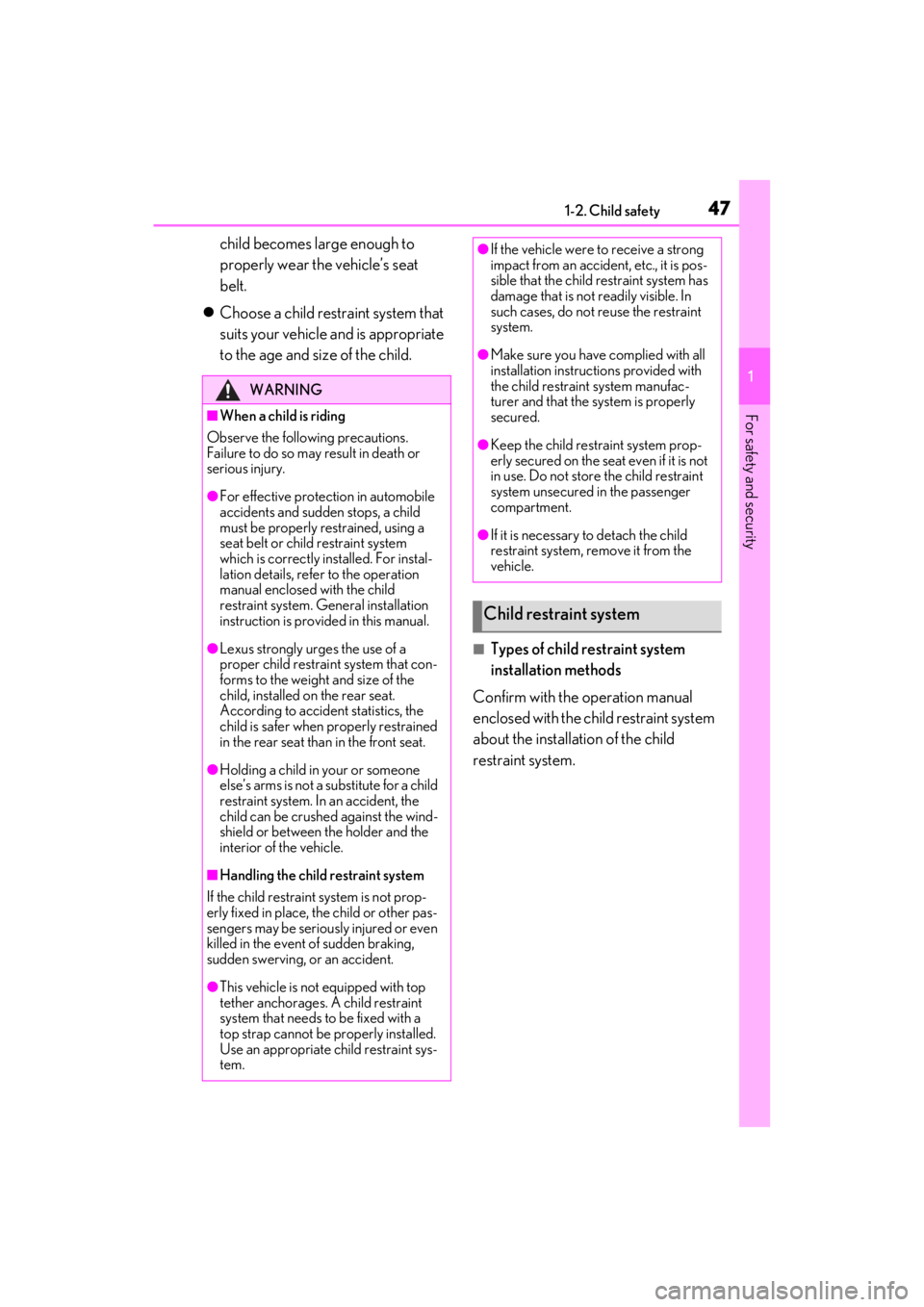
471-2. Child safety
1
For safety and security
child becomes large enough to
properly wear the vehicle’s seat
belt.
Choose a child restraint system that
suits your vehicle and is appropriate
to the age and size of the child.
■Types of child restraint system
installation methods
Confirm with the operation manual
enclosed with the child restraint system
about the installation of the child
restraint system.
WARNING
■When a child is riding
Observe the following precautions.
Failure to do so may result in death or
serious injury.
●For effective protection in automobile
accidents and sudden stops, a child
must be properly restrained, using a
seat belt or child restraint system
which is correctly installed. For instal-
lation details, refer to the operation
manual enclosed with the child
restraint system. General installation
instruction is provided in this manual.
●Lexus strongly urges the use of a
proper child restraint system that con-
forms to the weight and size of the
child, installed on the rear seat.
According to accident statistics, the
child is safer when properly restrained
in the rear seat than in the front seat.
●Holding a child in your or someone
else’s arms is not a substitute for a child
restraint system. In an accident, the
child can be crushed against the wind-
shield or between the holder and the
interior of the vehicle.
■Handling the child restraint system
If the child restraint system is not prop-
erly fixed in place, the child or other pas-
sengers may be seriou sly injured or even
killed in the event of sudden braking,
sudden swerving, or an accident.
●This vehicle is not equipped with top
tether anchorages. A child restraint
system that needs to be fixed with a
top strap cannot be pr operly installed.
Use an appropriate child restraint sys-
tem.
●If the vehicle were to receive a strong
impact from an accident, etc., it is pos-
sible that the child restraint system has
damage that is not readily visible. In
such cases, do not reuse the restraint
system.
●Make sure you have complied with all
installation instructions provided with
the child restraint system manufac-
turer and that the system is properly
secured.
●Keep the child rest raint system prop-
erly secured on the seat even if it is not
in use. Do not store the child restraint
system unsecured in the passenger
compartment.
●If it is necessary to detach the child
restraint system, remove it from the
vehicle.
Child restraint system
Page 50 of 410
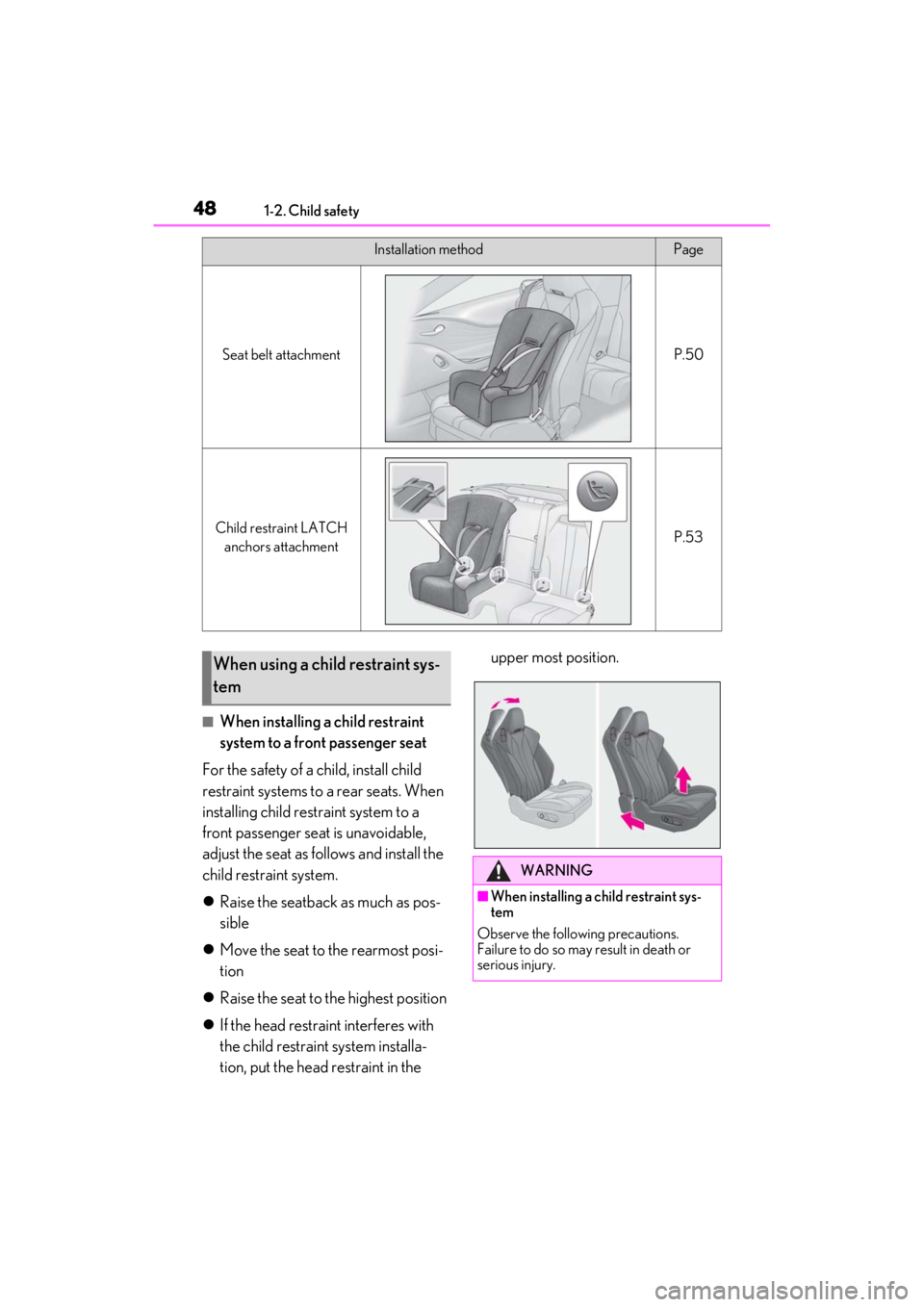
481-2. Child safety
■When installing a child restraint
system to a front passenger seat
For the safety of a child, install child
restraint systems to a rear seats. When
installing child restraint system to a
front passenger seat is unavoidable,
adjust the seat as follows and install the
child restraint system.
Raise the seatback as much as pos-
sible
Move the seat to the rearmost posi-
tion
Raise the seat to the highest position
If the head restraint interferes with
the child restraint system installa-
tion, put the head restraint in the upper most position.
Installation methodPage
Seat belt attachmentP.50
Child restraint LATCH
anchors attachmentP.53
When using a child restraint sys-
tem
WARNING
■When installing a child restraint sys-
tem
Observe the following precautions.
Failure to do so may result in death or
serious injury.
Page 51 of 410
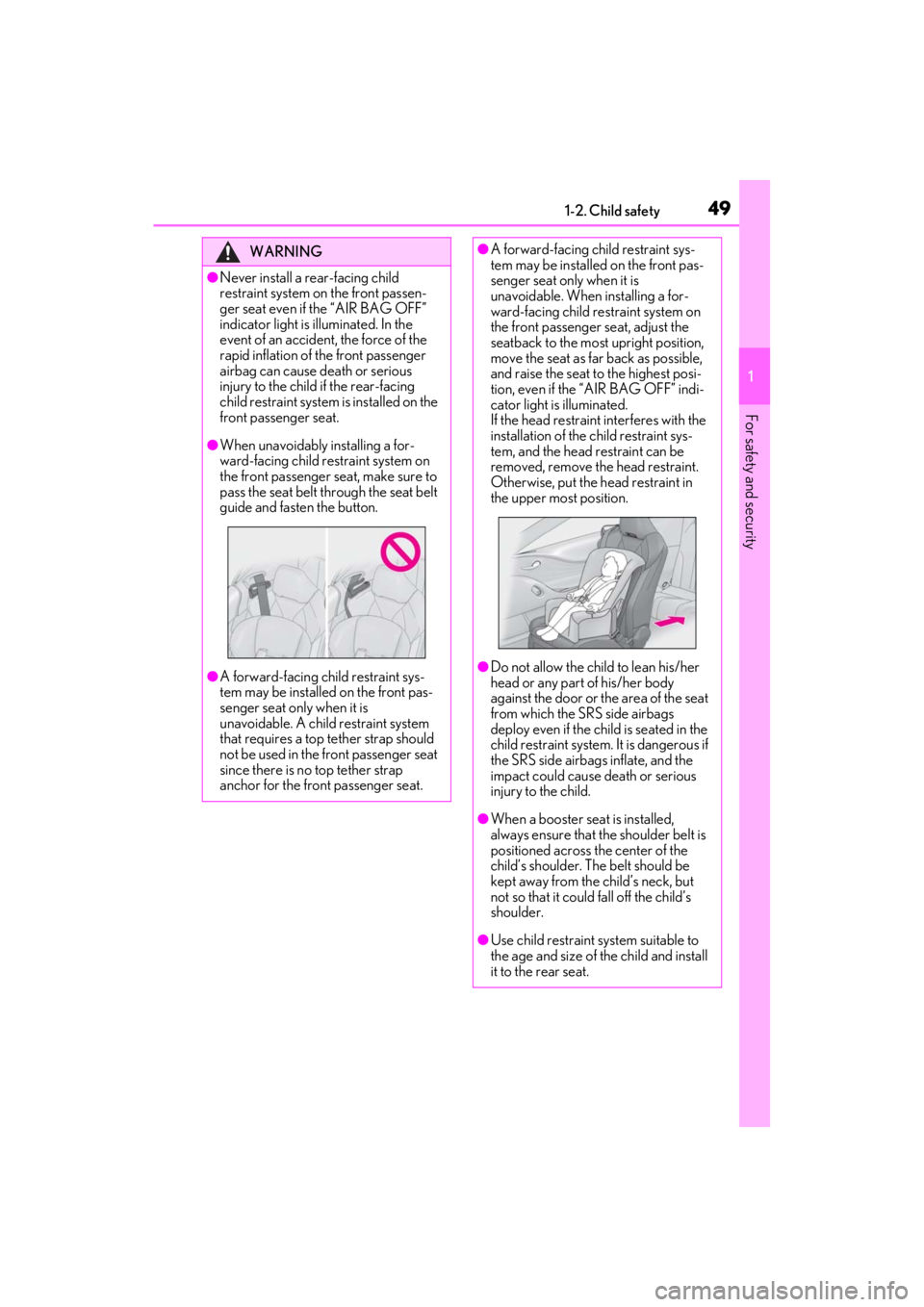
491-2. Child safety
1
For safety and security
WARNING
●Never install a rear-facing child
restraint system on the front passen-
ger seat even if the “AIR BAG OFF”
indicator light is illuminated. In the
event of an accident, the force of the
rapid inflation of the front passenger
airbag can cause death or serious
injury to the child if the rear-facing
child restraint system is installed on the
front passenger seat.
●When unavoidably installing a for-
ward-facing child restraint system on
the front passenger seat, make sure to
pass the seat belt th rough the seat belt
guide and fasten the button.
●A forward-facing child restraint sys-
tem may be installed on the front pas-
senger seat only when it is
unavoidable. A child restraint system
that requires a top tether strap should
not be used in the front passenger seat
since there is no top tether strap
anchor for the front passenger seat.
●A forward-facing child restraint sys-
tem may be installed on the front pas-
senger seat only when it is
unavoidable. When installing a for-
ward-facing child restraint system on
the front passenger seat, adjust the
seatback to the most upright position,
move the seat as fa r back as possible,
and raise the seat to the highest posi-
tion, even if the “AIR BAG OFF” indi-
cator light is illuminated.
If the head restraint interferes with the
installation of the child restraint sys-
tem, and the head restraint can be
removed, remove the head restraint.
Otherwise, put the head restraint in
the upper most position.
●Do not allow the child to lean his/her
head or any part of his/her body
against the door or the area of the seat
from which the SRS side airbags
deploy even if the child is seated in the
child restraint system. It is dangerous if
the SRS side airbags inflate, and the
impact could cause death or serious
injury to the child.
●When a booster seat is installed,
always ensure that th e shoulder belt is
positioned across the center of the
child’s shoulder. The belt should be
kept away from the child’s neck, but
not so that it could fall off the child’s
shoulder.
●Use child restraint system suitable to
the age and size of the child and install
it to the rear seat.
Page 52 of 410
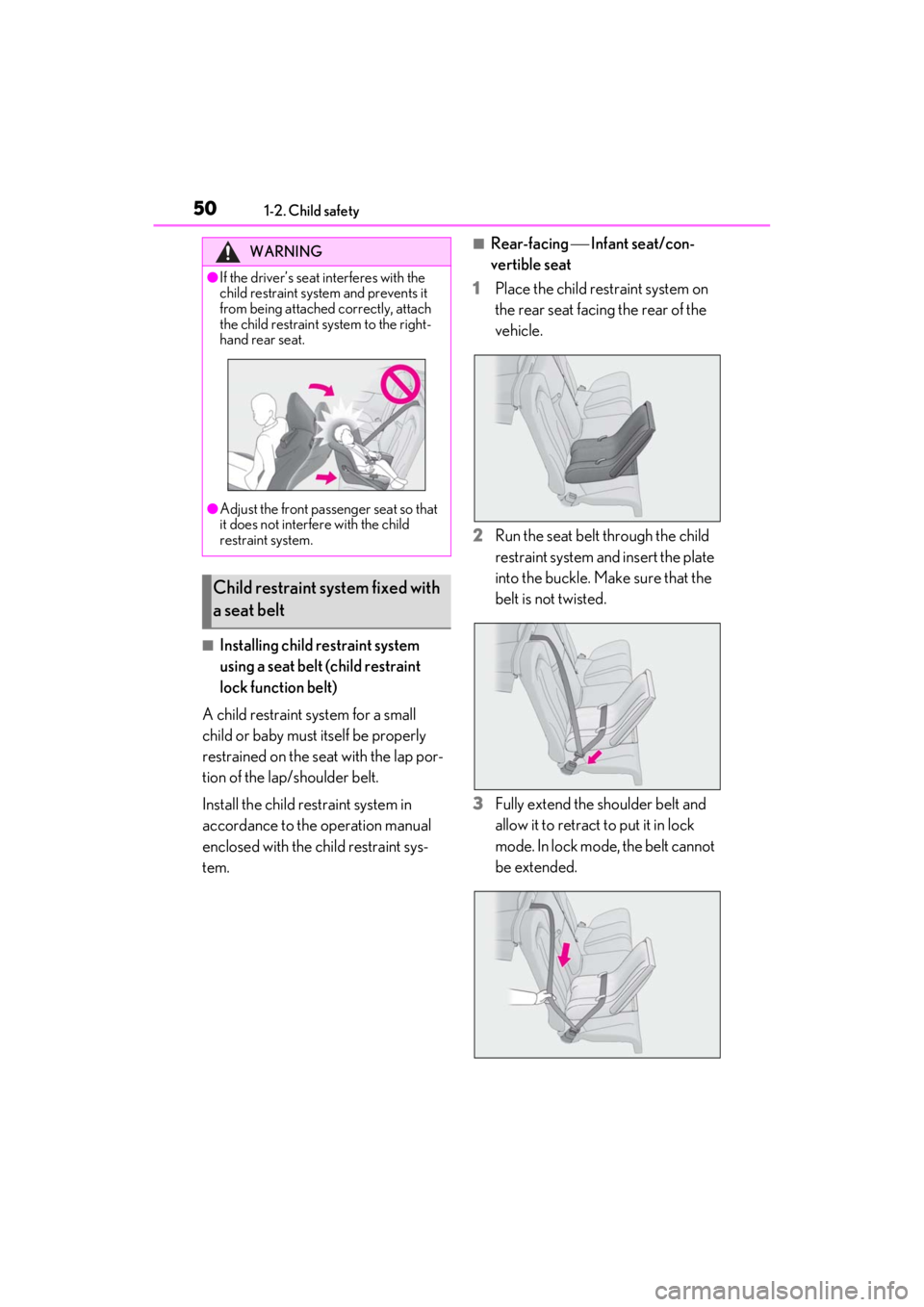
501-2. Child safety
■Installing child restraint system
using a seat belt (child restraint
lock function belt)
A child restraint system for a small
child or baby must itself be properly
restrained on the seat with the lap por-
tion of the lap/shoulder belt.
Install the child restraint system in
accordance to the operation manual
enclosed with the child restraint sys-
tem.
■Rear-facing Infant seat/con-
vertible seat
1
Place the child restraint system on
the rear seat facing the rear of the
vehicle.
2
Run the seat belt through the child
restraint system and insert the plate
into the buckle. Make sure that the
belt is not twisted.
3
Fully extend the shoulder belt and
allow it to retract to put it in lock
mode. In lock mode, the belt cannot
be extended.
WARNING
●If the driver’s seat interferes with the
child restraint system and prevents it
from being attached correctly, attach
the child restraint system to the right-
hand rear seat.
●Adjust the front passenger seat so that
it does not interfere with the child
restraint system.
Child restraint system fixed with
a seat belt
Page 53 of 410
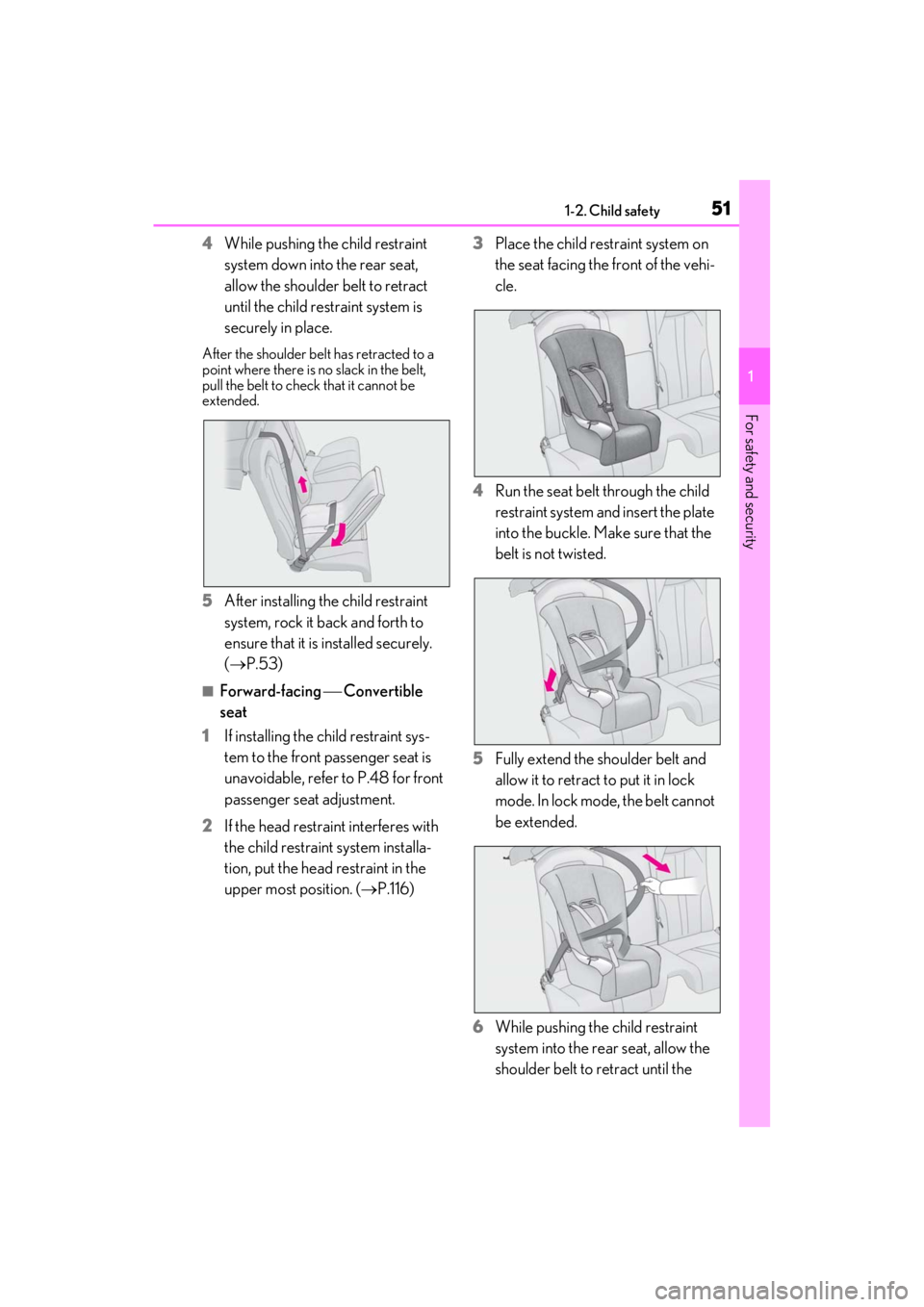
511-2. Child safety
1
For safety and security
4While pushing the child restraint
system down into the rear seat,
allow the shoulder belt to retract
until the child restraint system is
securely in place.
After the shoulder belt has retracted to a
point where there is no slack in the belt,
pull the belt to check that it cannot be
extended.
5After installing the child restraint
system, rock it back and forth to
ensure that it is installed securely.
(P.53)
■Forward-facing Convertible
seat
1 If installing the child restraint sys-
tem to the front passenger seat is
unavoidable, refer to P.48 for front
passenger seat adjustment.
2 If the head restraint interferes with
the child restraint system installa-
tion, put the head restraint in the
upper most position. ( P.116) 3
Place the child restraint system on
the seat facing the front of the vehi-
cle.
4 Run the seat belt through the child
restraint system and insert the plate
into the buckle. Make sure that the
belt is not twisted.
5 Fully extend the shoulder belt and
allow it to retract to put it in lock
mode. In lock mode, the belt cannot
be extended.
6 While pushing the child restraint
system into the rear seat, allow the
shoulder belt to retract until the